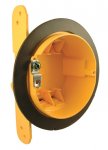So, under that interpretation, just wiring up interior receptacles in an outside wall will require use of UF, even if there is no outside connection at all?
The vapor barrier on an outside wall will typically be right behind the finish wallboard.
No It may be different here in Oregon the vapor barrier must be on the outside of the studs that plastic under finish sheetrock is linked to black mould and has been prohibited.
Here is a image from the code detailing what I think the OP is talking about, going from studs through a vapor barrior to a WP box set in the brick:Oregon Residential Specialty Code said:EXTERIOR COVERING
R703.1 General. Exterior walls shall provide the building with
a weather-resistant exterior wall envelope and a means of
draining water that enters the assembly to the exterior. Protec-
tion against condensation in the exterior wall assembly shall be
provided in accordance with Chapter 11 of this code.
R703.1.1 Exterior wall envelope. The exterior wall enve-
lope shall be installed in a manner that water that enters the
assembly can drain to the exterior. The envelope shall con-
sist of an exterior veneer, a water-resistive barrier as
required in Section R703.2, a minimum 1/8 inch (3 mm)
space between the water- resistive barrier and the exterior
veneer, and integrated flashings as required in Section
R703.8. The required space shall be formed by the use of
any noncorrodible furring strip, drainage mat or drainage
board. The envelope shall provide proper integration of
flashings with the water-resistive barrier, the space provided
and the exterior veneer. These components, in conjunction,
shall provide a means of draining water that enters the
assembly to the exterior.

If that brick were not there then a box nailed on a stud facing out with the barrier cut around the box would be OK to terminate romex.
There are also products the provide additional protection:
http://www.hubbellcatalog.com/raco/RACO_datasheet.asp?PN=2027-FBAR&FAM=RacoBoxes

and arlington makes a box that might allow him to use romex
http://www.aifittings.com/catalog/weatherproof-products/low-profile-inbox-for-new-brick/
However he stated he is using UF so its a non issue interms of the OP.
The only connector he can use to go into that bell box is one like this:
http://www.aifittings.com/catalog/non-metallic-fittings-and-supports/zinc-uf-connectors/
